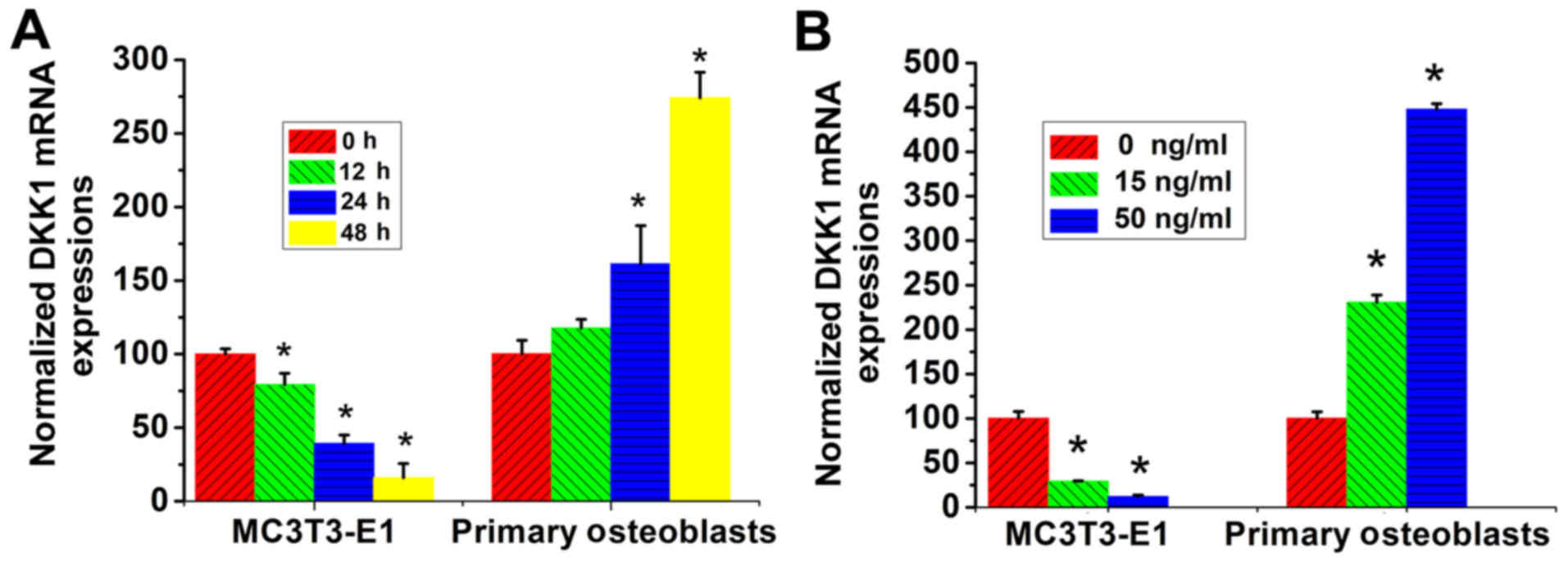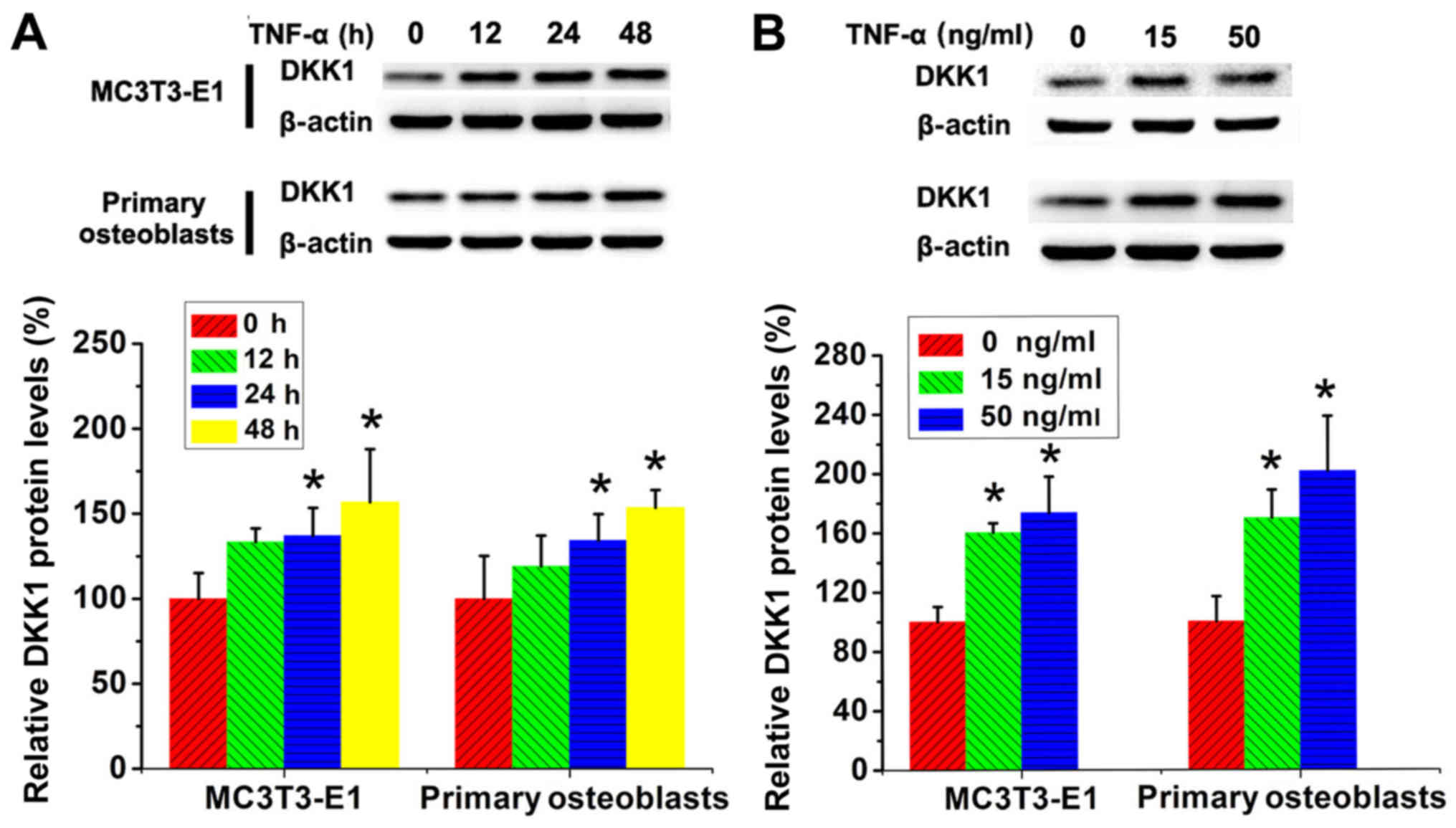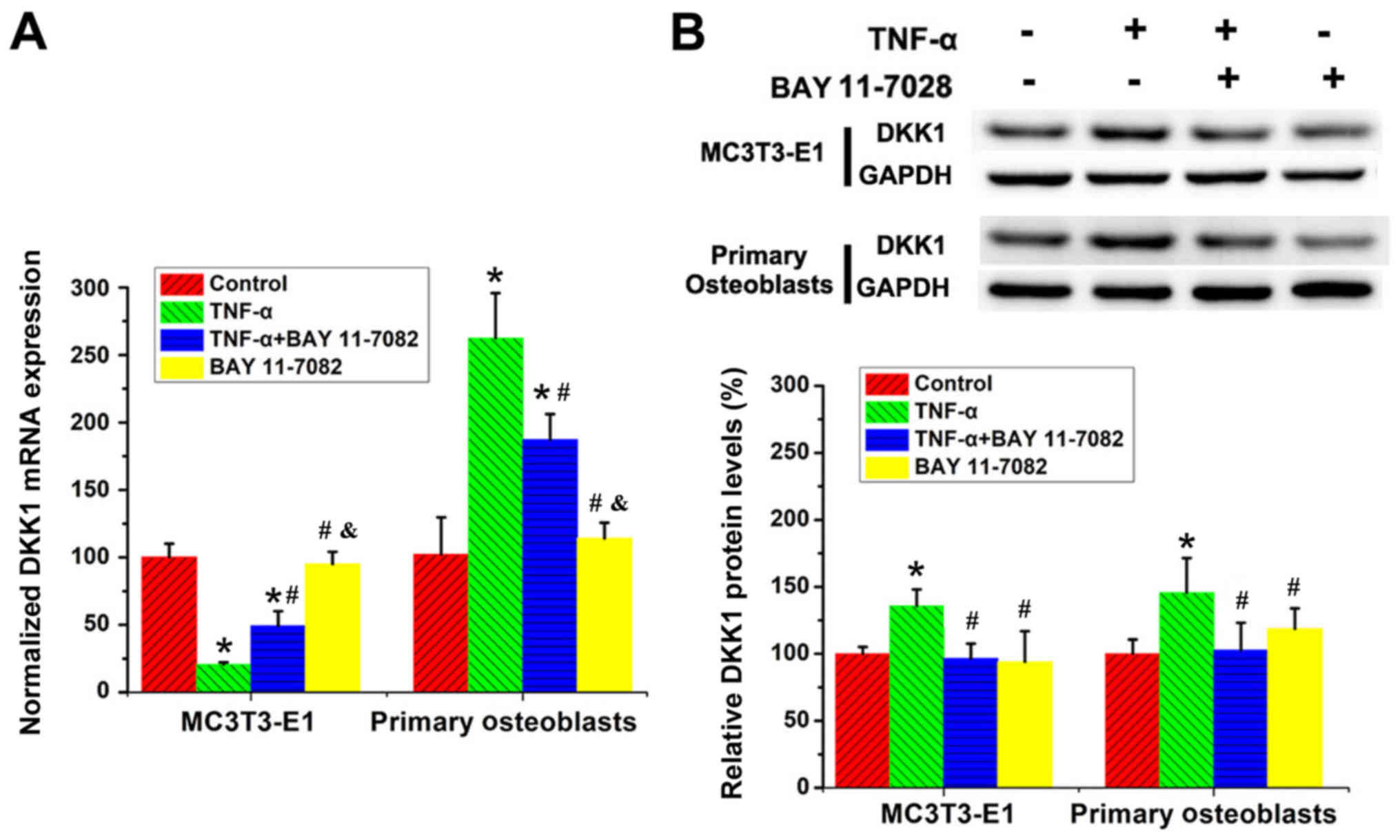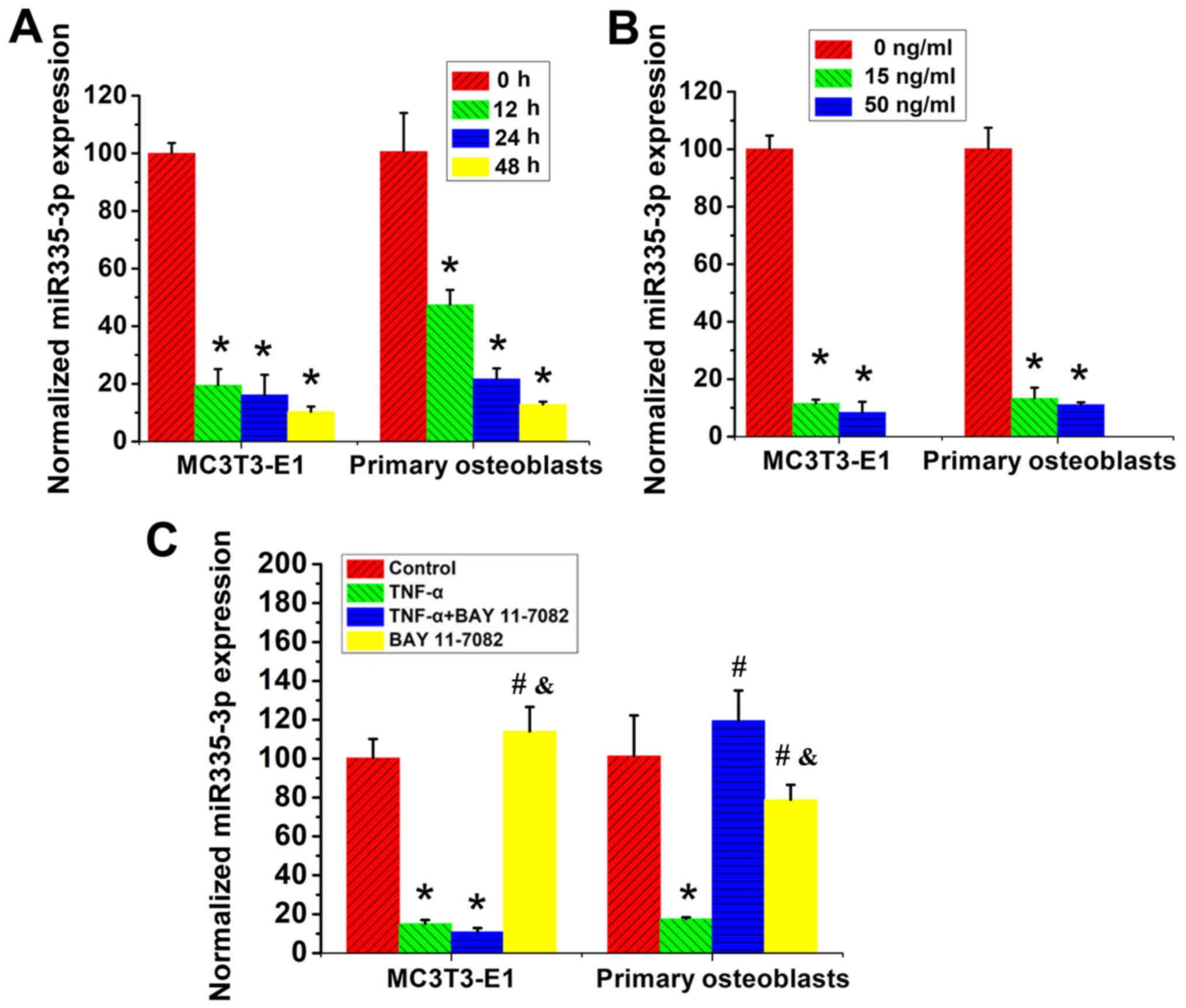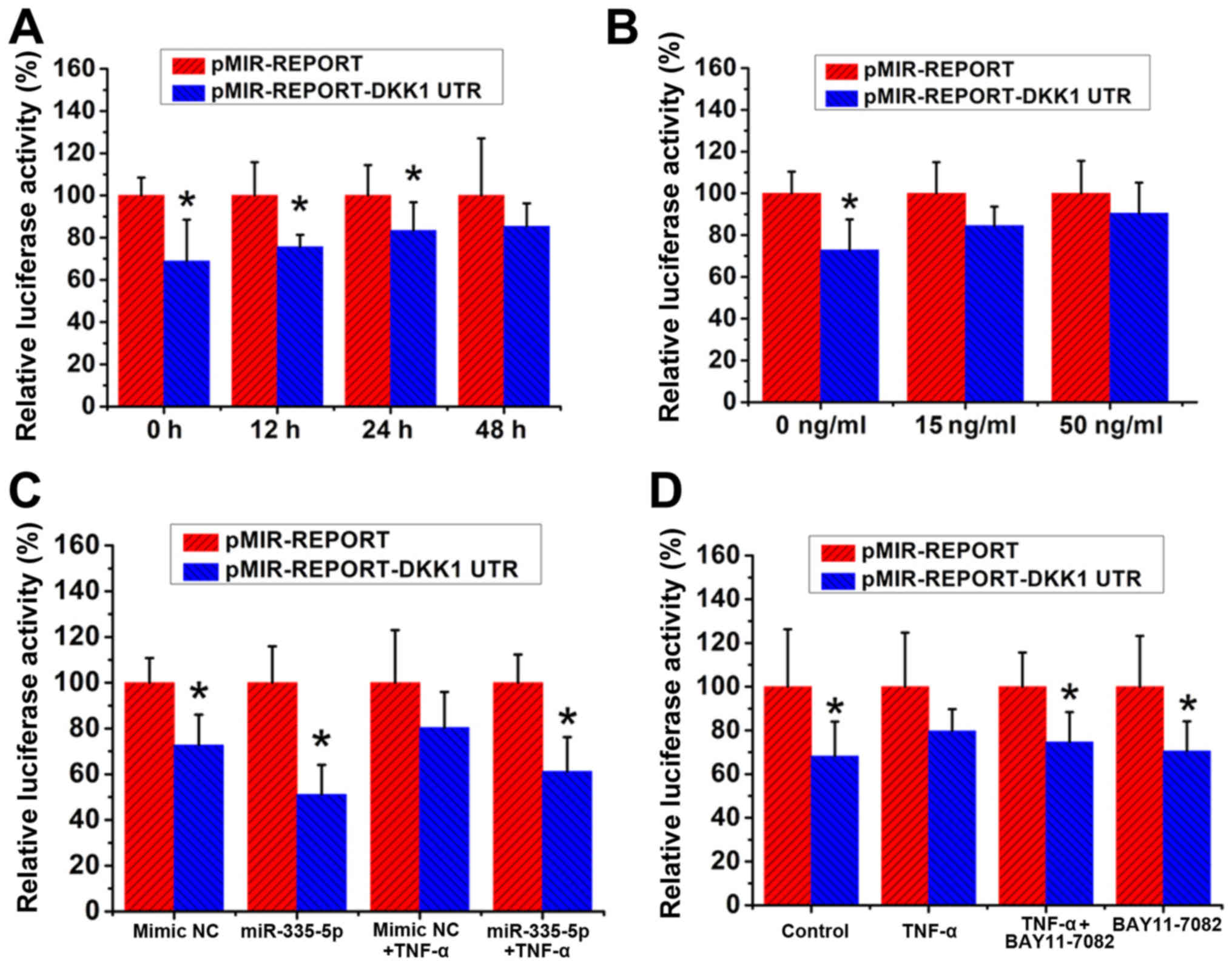|
1
|
Taurog JD, Chhabra A and Colbert RA:
Ankylosing spondylitis and axial spondyloarthritis. N Engl J Med.
374:2563–2574. 2016. View Article : Google Scholar : PubMed/NCBI
|
|
2
|
Wu X, Gu Q, Chen X, Mi W, Wu T and Huang
H: MiR-27a targets DKK2 and SFRP1 to promote reosseointegration in
the regenerative treatment of peri-implantitis. J Bone Miner Res.
34:123–134. 2019. View Article : Google Scholar : PubMed/NCBI
|
|
3
|
Yang N, Wang G, Hu C, Shi Y, Liao L, Shi
S, Cai Y, Cheng S, Wang X, Liu Y, et al: Tumor necrosis factor α
suppresses the mesenchymal stem cell osteogenesis promoter miR-21
in estrogen deficiency-induced osteoporosis. J Bone Miner Res.
28:559–573. 2013. View Article : Google Scholar : PubMed/NCBI
|
|
4
|
Magrey MN and Khan MA: The paradox of bone
formation and bone loss in ankylosing spondylitis: Evolving new
concepts of bone formation and future trends in management. Curr
Rheumatol Rep. 19:172017. View Article : Google Scholar : PubMed/NCBI
|
|
5
|
Weitzmann MN: Bone and the immune system.
Toxicol Pathol. 45:911–924. 2017. View Article : Google Scholar : PubMed/NCBI
|
|
6
|
Sun SC, Chang JH and Jin J: Regulation of
nuclear factor-κB in autoimmunity. Trends Immunol. 34:282–289.
2013. View Article : Google Scholar : PubMed/NCBI
|
|
7
|
Litke JL and Jaffrey SR: Highly efficient
expression of circular RNA aptamers in cells using autocatalytic
transcripts. Nat Biotechnol. 37:667–675. 2019. View Article : Google Scholar : PubMed/NCBI
|
|
8
|
Keller SA, Schattner EJ and Cesarman E:
Inhibition of NF-kappaB induces apoptosis of KSHV-infected primary
effusion lymphoma cells. Blood. 96:2537–2542. 2000. View Article : Google Scholar : PubMed/NCBI
|
|
9
|
Kunkemoeller B, Bancroft T, Xing H, Morris
AH, Luciano AK, Wu J, Fernandez-Hernando C and Kyriakides TR:
Elevated thrombospondin 2 contributes to delayed wound healing in
diabetes. Diabetes. 68:2016–2023. 2019. View Article : Google Scholar : PubMed/NCBI
|
|
10
|
Salahuddin S, Fath EK, Biel N, Ray A, Moss
CR, Patel A, Patel S, Hilding L, Varn M, Ross T, et al:
Epstein-barr virus latent membrane protein-1 induces the expression
of SUMO-1 and SUMO-2/3 in LMP1-positive lymphomas and cells. Sci
Rep. 9:2082019. View Article : Google Scholar : PubMed/NCBI
|
|
11
|
Osta B, Benedetti G and Miossec P:
Classical and paradoxical effects of TNF-α on bone homeostasis.
Front Immunol. 5:482014. View Article : Google Scholar : PubMed/NCBI
|
|
12
|
Guo X and Wang XF: Signaling cross-talk
between TGF-beta/BMP and other pathways. Cell Res. 19:71–88. 2009.
View Article : Google Scholar : PubMed/NCBI
|
|
13
|
Zhang J, Tu Q, Bonewald LF, He X, Stein G,
Lian J and Chen J: Effects of miR-335-5p in modulating osteogenic
differentiation by specifically downregulating Wnt antagonist DKK1.
J Bone Miner Res. 26:1953–1963. 2011. View
Article : Google Scholar : PubMed/NCBI
|
|
14
|
Maeda Y, Farina NH, Matzelle MM, Fanning
PJ, Lian JB and Gravallese EM: Synovium-derived MicroRNAs regulate
bone pathways in rheumatoid arthritis. J Bone Miner Res.
32:461–472. 2017. View Article : Google Scholar : PubMed/NCBI
|
|
15
|
Sang C, Zhang Y, Chen F, Huang P, Qi J,
Wang P, Zhou Q, Kang H, Cao X and Guo L: Tumor necrosis factor
alpha suppresses osteogenic differentiation of MSCs by inhibiting
semaphorin 3B via Wnt/β-catenin signaling in estrogen-deficiency
induced osteoporosis. Bone. 84:78–87. 2016. View Article : Google Scholar : PubMed/NCBI
|
|
16
|
Diarra D, Stolina M, Polzer K, Zwerina J,
Ominsky MS, Dwyer D, Korb A, Smolen J, Hoffmann M, Scheinecker C,
et al: Dickkopf-1 is a master regulator of joint remodeling. Nat
Med. 13:156–163. 2007. View
Article : Google Scholar : PubMed/NCBI
|
|
17
|
Pritchard CC, Cheng HH and Tewari M:
MicroRNA profiling: Approaches and considerations. Nat Rev Genet.
13:358–369. 2012. View
Article : Google Scholar : PubMed/NCBI
|
|
18
|
Hassan MQ, Maeda Y, Taipaleenmaki H, Zhang
W, Jafferji M, Gordon JA, Li Z, Croce CM, van Wijnen AJ, Stein JL,
et al: miR-218 directs a Wnt signaling circuit to promote
differentiation of osteoblasts and osteomimicry of metastatic
cancer cells. J Biol Chem. 287:42084–42092. 2012. View Article : Google Scholar : PubMed/NCBI
|
|
19
|
Wang W, Yang L, Zhang D, Gao C, Wu J, Zhu
Y and Zhang H: MicroRNA-218 negatively regulates osteoclastogenic
differentiation by repressing the nuclear factor-κB signaling
pathway and targeting tumor necrosis factor receptor 1. Cell
Physiol Biochem. 48:339–347. 2018. View Article : Google Scholar : PubMed/NCBI
|
|
20
|
Deng L, Hu G, Jin L, Wang C and Niu H:
Involvement of microRNA-23b in TNF-alpha-reduced BMSC osteogenic
differentiation via targeting runx2. J Bone Miner Metab.
36:648–660. 2018. View Article : Google Scholar : PubMed/NCBI
|
|
21
|
Mi W, Shi Q, Chen X, Wu T and Huang H:
miR-33a-5p modulates TNF-alpha-inhibited osteogenic differentiation
by targeting SATB2 expression in hBMSCs. FEBS Lett. 590:396–407.
2016. View Article : Google Scholar : PubMed/NCBI
|
|
22
|
Li C, Zhang P and Gu J: miR-29a modulates
tumor necrosis factor-α-induced osteogenic inhibition by targeting
Wnt antagonists. Dev Growth Differ. 57:264–273. 2015. View Article : Google Scholar : PubMed/NCBI
|
|
23
|
Sui L, Wang M, Han Q, Yu L, Zhang L, Zheng
L, Lian J, Zhang J, Valverde P, Xu Q, et al: A novel
Lipidoid-MicroRNA formulation promotes calvarial bone regeneration.
Biomaterials. 177:88–97. 2018. View Article : Google Scholar : PubMed/NCBI
|
|
24
|
Livak KJ and Schmittgen TD: Analysis of
relative gene expression data using real-time quantitative PCR and
the 2(-Delta Delta C(T)) method. Methods. 25:402–408. 2001.
View Article : Google Scholar : PubMed/NCBI
|
|
25
|
Matzelle MM, Gallant MA, Condon KW, Walsh
NC, Manning CA, Stein GS, Lian J B, Burr DB and Gravallese EM:
Resolution of inflammation induces osteoblast function and
regulates the Wnt signaling pathway. Arthritis Rheum. 64:1540–1550.
2012. View Article : Google Scholar : PubMed/NCBI
|
|
26
|
Walsh NC and Gravallese EM: Bone
remodeling in rheumatic disease: A question of balance. Immunol
Rev. 233:301–312. 2010. View Article : Google Scholar : PubMed/NCBI
|
|
27
|
Quarles LD, Yohay DA, Lever LW, Caton R
and Wenstrup RJ: Distinct proliferative and differentiated stages
of murine MC3T3-E1 cells in culture: An in vitro model of
osteoblast development. J Bone Miner Res. 7:683–692. 1992.
View Article : Google Scholar : PubMed/NCBI
|
|
28
|
Arriero Mdel M, Ramis JM, Perelló J and
Monjo M: Differential response of MC3T3-E1 and human mesenchymal
stem cells to inositol hexakisphosphate. Cell Physiol Biochem.
30:974–986. 2012. View Article : Google Scholar : PubMed/NCBI
|
|
29
|
Naismith JH and Sprang SR: Tumor necrosis
factor receptor superfamily. J Inflamm. 47:1–7. 1995.PubMed/NCBI
|
|
30
|
Idriss HT and Naismith JH: TNF alpha and
the TNF receptor superfamily: Structure-function relationship(s).
Microsc Res Tech. 50:184–195. 2000. View Article : Google Scholar : PubMed/NCBI
|
|
31
|
Huang H, Zhao N, Xu X, Xu Y, Li S, Zhang J
and Yang P: Dose-specific effects of tumor necrosis factor alpha on
osteogenic differentiation of mesenchymal stem cells. Cell Prolif.
44:420–427. 2011. View Article : Google Scholar : PubMed/NCBI
|
|
32
|
Zhao B: TNF and bone remodeling. Curr
Osteoporos Rep. 15:126–134. 2017. View Article : Google Scholar : PubMed/NCBI
|
|
33
|
Wang L, Zhang J, Wang C, Qi Y, Du M, Liu
W, Yang C and Yang P: Low concentrations of TNF-α promote
osteogenic differentiation via activation of the ephrinB2-EphB4
signalling pathway. Cell Prolif. 50:e123112017. View Article : Google Scholar
|
|
34
|
Karnes JM, Daffner SD and Watkins CM:
Multiple roles of tumor necrosis factor-alpha in fracture healing.
Bone. 78:87–93. 2015. View Article : Google Scholar : PubMed/NCBI
|
|
35
|
Wang FS, Chuang PC, Lin CL, Chen MW, Ke
HJ, Chang YH, Chen YS, Wu SL and Ko JY: MicroRNA-29a protects
against glucocorticoid-induced bone loss and fragility in rats by
orchestrating bone acquisition and resorption. Arthritis Rheum.
65:1530–1540. 2013. View Article : Google Scholar : PubMed/NCBI
|
|
36
|
Redlich K and Smolen JS: Inflammatory bone
loss: Pathogenesis and therapeutic intervention. Nat Rev Drug
Discov. 11:234–250. 2012. View Article : Google Scholar : PubMed/NCBI
|
|
37
|
Jing Y, Feng J ZH, Zhao X, Yang J, Bai D
and Han X: Role of DKK1 in periodontitis and innovative strategy
with its neutralizing antibody for periodontitis treatment. OHDM.
13:994–997. 2014.
|
|
38
|
Heiland GR, Zwerina K, Baum W, Kireva T,
Distler JH, Grisanti M, Asuncion F, Li X, Ominsky M, Richards W, et
al: Neutralisation of Dkk-1 protects from systemic bone loss during
inflammation and reduces sclerostin expression. Ann Rheum Dis.
69:2152–2159. 2010. View Article : Google Scholar : PubMed/NCBI
|
|
39
|
Juliana C, Fernandes-Alnemri T, Wu J,
Datta P, Solorzano L, Yu JW, Meng R, Quong AA, Latz E, Scott CP and
Alnemri ES: Anti-inflammatory compounds parthenolide and Bay
11-7082 are direct inhibitors of the inflammasome. J Biol Chem.
285:9792–9802. 2010. View Article : Google Scholar : PubMed/NCBI
|
|
40
|
Xu L, Zhang L, Wang Z, Li C, Li S, Li L,
Fan Q and Zheng L: Melatonin suppresses estrogen deficiency-induced
osteoporosis and promotes osteoblastogenesis by inactivating the
NLRP3 inflammasome. Calcif Tissue Int. 103:400–410. 2018.
View Article : Google Scholar : PubMed/NCBI
|
|
41
|
Huang RL, Yuan Y, Tu J, Zou GM and Li Q:
Opposing TNF-α/IL-1β- and BMP-2-activated MAPK signaling pathways
converge on Runx2 to regulate BMP-2-induced osteoblastic
differentiation. Cell Death Dis. 5:e11872014. View Article : Google Scholar : PubMed/NCBI
|















